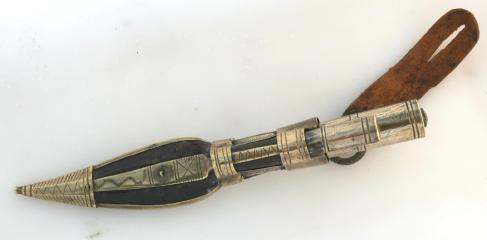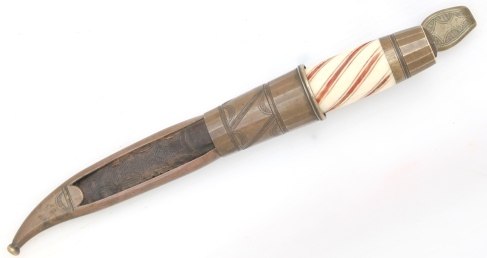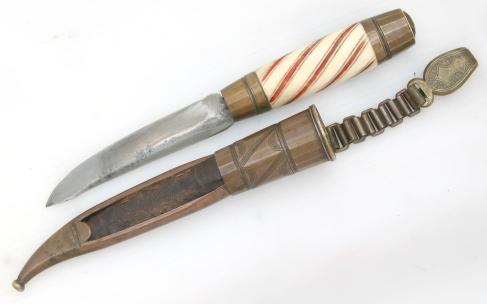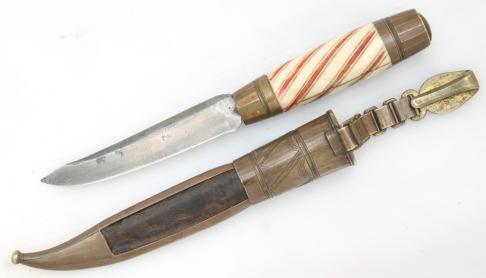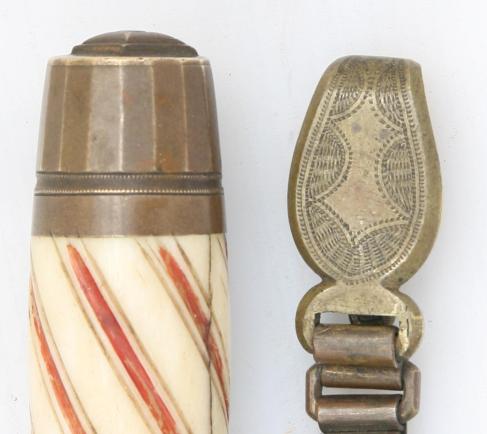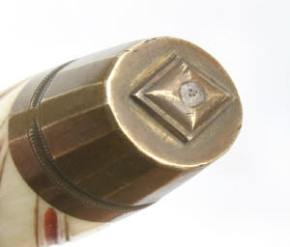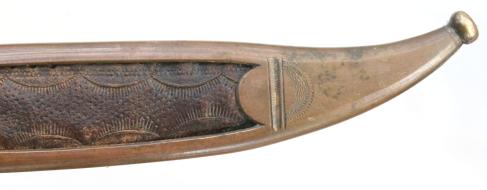This post is focused on the work of Teuvo Sorvari and the historical puukkos he creates especially the Vöyrin puukko. When I first became interested in puukko I saw his Vöyri knives and thought they were the most beautiful and exotic puukkos of all. There is not much information available on this style of puukko so I am especially pleased to be able to feature them here, along with the Inarin and Renfors style of puukko . My special thanks to Juha Nikki for this article and to Teuvo Sorvari for allowing us access to his work.
Teuvo Sorvari by Juha Nikki
Teuvo Sorvari is a knifesmith working in the town of Kaarina, Finland, just outside the former capital Turku. He started knife making in earnest in 1998, making a knife using a blade by Eetu Heikkinen. He has since used only his own blades and won several accolades for his precise work. He is one of the very few modern makers of Vöyrin puukko – in fact it’s difficult to find any other recent Vöyrin puukkos. Teuvo’s work is not confined to that particular style, however. He has made a range of different types of knives from traditional Finnish puukko to bowie knives, fulltangs and liner lock folders – even some types of knife that are entirely unique in their construction.
While Teuvo prefers making completely unique knives, at the time of the interview he was beginning the process of making a slightly larger batch of knives. When asked what his “mission” as a knifesmith is, his reaction to the grand word is initially amusement, but after a brief pause he replies: “If it’s worth doing, it’s worth doing properly”.
Teuvo has a history of being an active member of Suomen Puukkoseura (the Finnish Knife Society), including a period as the editor of the society’s quarterly magazine Puukkoposti from 2003-2009. He’s been involved with arranging the Fiskars puukko events with its Finnish puukko making championships and been on the panel of judges there. The Helsinki Knife Show also benefits from his experience and work. He has also run community school knife courses for a number of years and continues to do so.
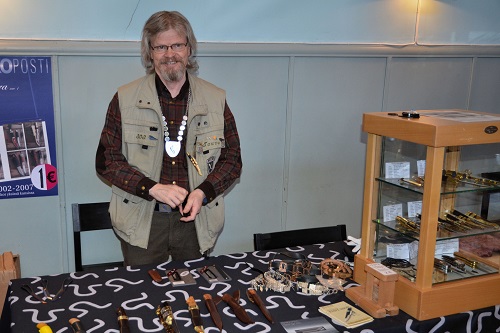
Teuvo Sorvari, Finnish Knifesmith of the Year 2012 – photo by Jukka Hankala taken the same year.
Going further back to history, Teuvo’s father was a metal worker and welder, also producing some sculptural pieces of art. He also made a small axe, which Teuvo got when he was four years old. He got his first knife when he was five.
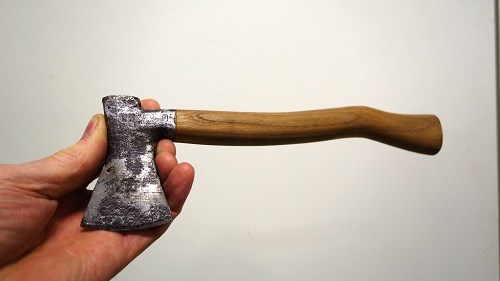
Teuvo’s first axe, made by his father.
Teuvo’s professional background is also in metalwork and making highly specialized unique machinery for various industries, laboratories and scientific outfits. He is mostly self taught in knife making apart from taking on a course for “sorkoupotus” (the art of embedding metal decorations to birch bark handles) and a blacksmithing course, on which he concentrated on making damascus billets.
He makes his own blades, knives and sheaths in his well-equipped workshop, and goes even further than that by manufacturing some of his tools himself. Notably, he produces his own gas-fired forge, which I believe is also available for purchase. He has a hydraulic press he’s modified from a log splitter, complete with heated “jaws”. This he uses for e.g. making damascus. His workshop, which is used for his business as well as the knife work, has been in the same place since 1990. It has a wealth of gear with areas for the office, woodworking, metalwork and leatherwork.
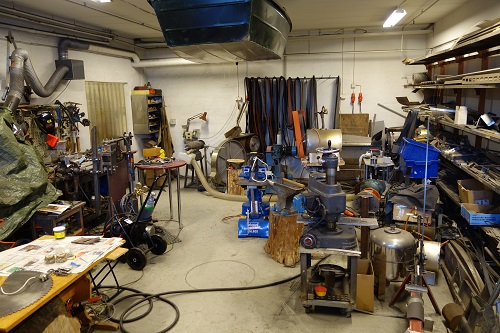
Metal working area of the workshop.
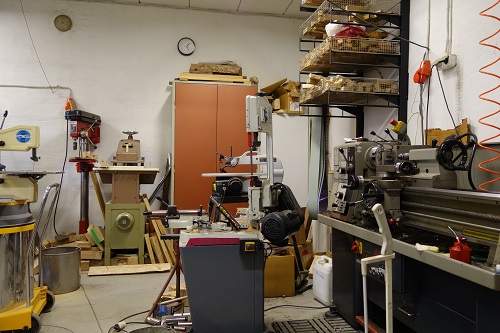
Another part of the extensive workshop.
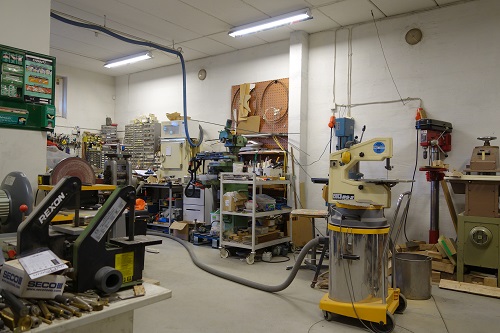
The workshop is used for both business and knife making.
As his hobbies Teuvo names photography, nature, fishing, hunting and woodworking. Occasionally he makes items of jewellery, too. The ceremonial livery collar awarded to the Knifesmith of the Year by Suomen Puukkoseura is his handiwork.
Teuvo is a reader of this Nordiska Knivar blog and has visited the site a few times, albeit not regularly. Mike, the blog owner, has tried to get him to feature through a couple of channels. I hope Mike’s curiosity towards obscure Finnish puukko styles will be satisfied at least a tiny bit after this feature. On that note, a few words about the Vöyrin puukko, which for many is closely associated with Teuvo Sorvari.
VÖYRIN PUUKKO
“Vöyrin puukko” translated to English is “the knife from Vöyri”. Vöyri is a mostly Swedish speaking small town or municipality in the Ostrobothnia region of Finland, just North of the city of Vaasa. Vöyri has a history of interesting archaeology and is the site of one of Finland’s earliest iron foundries from 1703.
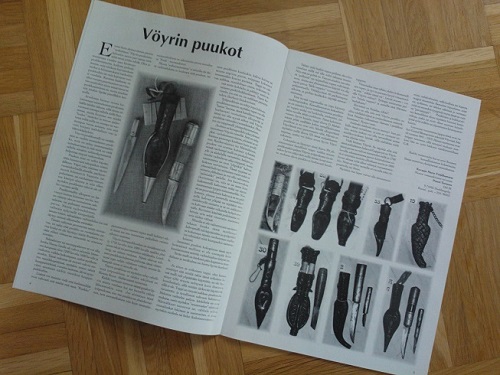
Vöyrin puukko featured in Puukkoposti magazine. (Photo by JN)
Teuvo kindly gave me a copy of the Puukkoposti magazine from 2003 which has an excellent two page story about Vöyrin puukko. It is written by knife historian Pentti Turunen, who had delved deep into the history of Vöyrin puukko (as well as numerous other puukkos) and may well have been the foremost expert on these knives. He has sadly already passed away. The article is obviously in Finnish, but I’ll try to convey some salient points here, coupled with some bits of information from the Finnish Wikipedia entry for Vöyrin puukko. As you have to take Wikipedia with a pinch of salt, I’ll try to stick to what seem like verifiable facts.
- The amount of surviving historical Vöyrin puukko is only some dozens (Turunen estimates about 40 pieces in 2003). A lot of the survivors are showing their age and have various blemishes and even bits missing.
- The origins of the knife style are obscured by time, but there are theories of it having a Germanic root through Hansa trade, as Vöyri is a coastal Baltic (trading) town. Finnish domestic, Swedish or European origins have also been mooted. Folk historian Sakari Pälsi reckoned the unique style of the symmetrical sheath was based on the Finnish nobility’s dagger sheaths. Turunen’s conclusion is that whatever the influences, it was the local Vöyri people who developed the sheath style to its final form.
- Wikipedia mentions the year 1750 as a possible date for the first Vöyrin puukko, but reminds us that puukkos have been made in Vöyri well before that.
- Turunen quotes the Lundberg family as a prominent maker of the decorative versions (dress knife) of Vöyrin puukko. It is possible they were the only historical Vöyri dress knife makers. The simpler everyday (user knife) versions have been by various others, notably the blacksmith Konsta Kruut from Alahärmä.
- The Lundbergs made Vöyrin puukkos between 1750-1880 in three generations, by the end of it there were four brothers involved, according to Turunen’s information.
- All Vöyrin puukkos have a straight handle. They can be either single knives or a double knife versions, where two knives are housed in the same sheath. The odd treble version of an everyday knife has also been made.
- In the modern day, the term “Vöyrin puukko” usually refers to the decorative version of the knife.
- Most handles are brass from top to bottom, but some also show a little timber in the middle section. There are solid brass handles, as well as those with a wooden core covered with brass plating.
- The handle decorations often include a criss-cross pattern and a wavy snaking line around the (top of the) handle.
- Turunen quotes Vöyrin puukko as the oldest Finnish knife style that has been manufactured in a reasonably large scale. Wikipedia also mentions it as “the first distinguishable puukko type of our modern time” – which can obviously be contested.
- There are also asymmetrical sheaths, which is to say that the rounded bottom part of the sheath is semi-circular instead of circular.
- The sheath is leather, usually with a wooden insert and a very strong, prominent brass framing, strengthening or decoration – whatever you want to call the brasswork. There can also be decorative brass strips on the flat middle part of the sheath.
- There are very rare examples of Vöyrin puukko with birch bark sheaths. See the photo of the Vöyrin puukko story with rare examples, including all leather, all metal and all birch bark versions as well as an asymmetrical sheath and a hat sheath. Whether some of the photos are actual Vöyrin puukko or sheaths could be questioned, but you can see where Turunen is coming from with those examples.
- Turunen moots the idea that Vöyrin puukko could be a predecessor or at least an inspiration for Toijalan puukko, another traditional Finnish model.
- There are also associated knife belts (helavyö) for Vöyrin puukko. According to Turunen they appeared in the early 1800’s. Most of the known belts were made by Gustaf Blomqvist (1841-1919) in Vöyri.
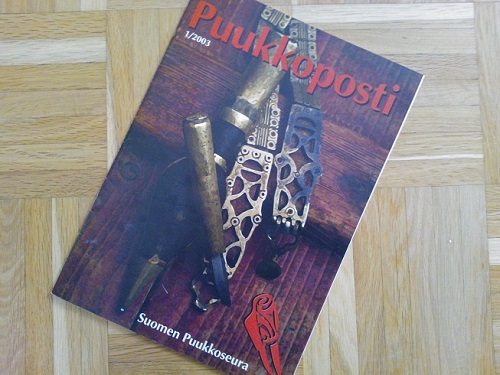
Puukkoposti from 2003, featuring Vöyri & Renfors puukko stories. The cover photo of a Vöyrin puukko and its belt is by Jukka Hankala. (Photo by JN)
Having compiled the above, I had a look at Anssi Ruusuvuori’s “Puukon Historia” (history of puukko) book. It has more detail for those interested in Vöyrin puukko. Ruusuvuori says they were made around 1740-1880 and suggests the sheath design is likely to be baroque influenced. Another reason for the sheath shape could be that these are some of the earliest puukko sheaths using a wooden insert, he says. There are quite a few photos of historical Vöyrin puukko in the book, as well as the full specifications and detailed photos of almost a couple of dozen of these very original knives.
TEUVO AND VÖYRIN PUUKKO
Teuvo Sorvari has made both single and double knife versions of Vöyrin puukko – the Finnish term for a small and larger knife in the same sheath is “kaksineuvoinen”. He got the idea and the model for making his first Vöyrin puukko from a Finnish interior design magazine called Avotakka. He then managed to borrow an original knife – or in fact a duo of knives in the same sheath, “kaksineuvoinen” – from Ilmo Juntunen to get the measurements from. The interpretation of the sheath on the first puukko is Teuvo’s own, as he didn’t inspect the original for the method of construction. He says his main objective was to make the sheath as compact as possible in terms of getting the two knives in the sheath as close as possible. One of these works has won for Teuvo first prize in the Heritage Knife category of the Finnish Knife (Puukko) Making Championships in 2004, as well as being voted the Most Beautiful Knife in the show by the audience.

A double Vöyrin puukko, maker Teuvo Sorvari.
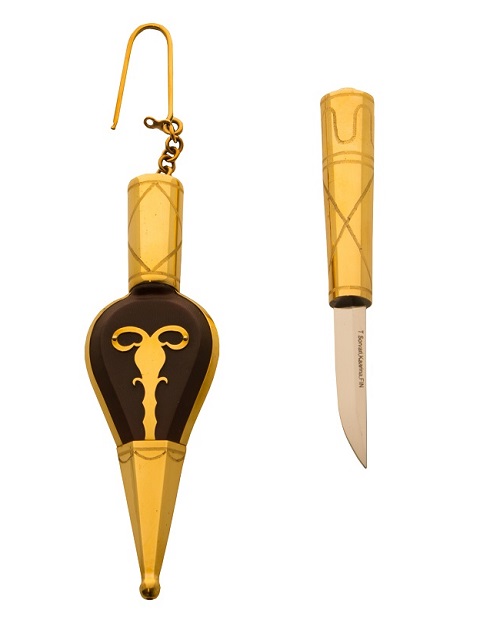
A single Vöyrin puukko by Teuvo Sorvari.
The Vöyri sheaths Teuvo makes are, according to the man himself, a little bit rounder, fuller in shape than a lot if the originals. As an anecdote, Anssi Ruusuvuori has measured Teuvo’s Vöyrin puukko for the purposes of his “Puukon Historia” book.
Another bit of information Teuvo shares is that the original patterns engraved on the handle will have been the criss-cross motif coupled with the snaking “worm” line. On the 2004 Vöyrin puukko he was too nervous to try this for fear of ruining the knife and he settled for some straight rings around the handle. The decoration from one original puukko to another varies somewhat too, so this isn’t necessarily a bad thing. Vöyri knives in general are very labour intensive, hence also expensive. This is likely one of the reasons for their rarity. Teuvo says he has never taught anyone else in making Vöyri knives.
INARIN PUUKKO
The Inari Knife (knife from Inari, Inarin puukko) is another historical style that Teuvo has tackled a few times. This is an archaeological find from Mihkaljärvi, Inari, situated in Finnish Lapland. The knife, dated to 1050-1300, in the Finnish National Museum also features in Anssi Ruusuvuori’s book “Puukon Historia” (The History of Puukko). Teuvo’s rendition of Inarin puukko has an ebony handle and a strikingly elaborate horizontal carry brass sheath. As the original find didn’t have any leather surviving, Teuvo hasn’t lined his completely with leather. Unlike the original, the spine on Teuvo’s sheath is solid brass, and the whole package is very solid with a good weight to it.
A photo of the original can be seen on this Sami Museum page:
http://www.samimuseum.fi/anaras/historia/historia.html

One of Teuvo Sorvari’s Inarin Puukko.
TEUVO AND RENFORS PUUKKO
Renfors puukko (Renforsin puukko) is a further relatively little known Finnish puukko. It is named after a gentleman called Herman August Renfors, a polymath, inventor and businessman who for a lot of his active career resided in Kajaani, Finland. You can find more on him by googling e.g. “renfors fishing”, as a some of his patents etc. were on fishing lures and such. Amongst his many inventions and products was a knife, which is now known as the Renfors puukko. Renfors also holds the first Finnish patent (from 1910) to do with knife making – or to be precise it concerns the use of metal with sheaths.
The Renfors puukkos Teuvo has made are all a series of three knives with beautiful, ornate brass clad leather sheaths like the originals. The knives in the set are in three sizes, otherwise they are identical. The smallest one – from the writer’s memory – is roughly 10 cm long with its sheath and the biggest knife I’d liken to a good sized regular Tommi-puukko or such. The knives themselves have ebony handles.

Teuvo Sorvari’s Renfors puukko set.
There is a good two page story on Renfors knives by Ilmo Juntunen in the same Puukkoposti magazine that has the Vöyrin puukko story. It is more about the man and his exploits than knives, but there are a few interesting nuggets regarding the puukkos, too. For example, the handles are said to be ebony and the size of the largest puukko 18,5 cm with the sheath and the smallest knife at 8,5 cm long. The story also asks to get into contact with Suomen Puukkoseura, if you have anything resembling a Renfors knife or sheaths. This is because they are so rare that even the regional county museum of Kainuu, the area where the knives were manufactured, hasn’t got an example – at least in 2003 when the story was written.
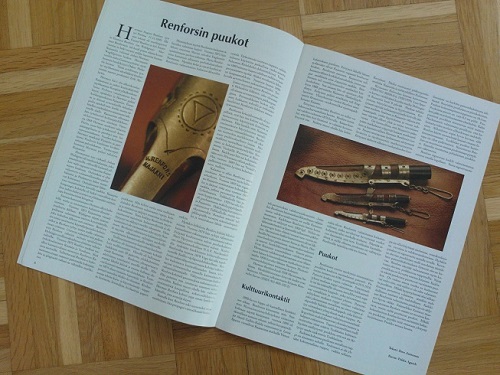
Renfors and his knives in Puukkoposti magazine (Photo by JN)
Renfors also had a special belt (helavyö) for these knives, which Teuvo has also reproduced.
“Puukon Historia” book has a little additional detail on this knife, too, with a couple of photos.
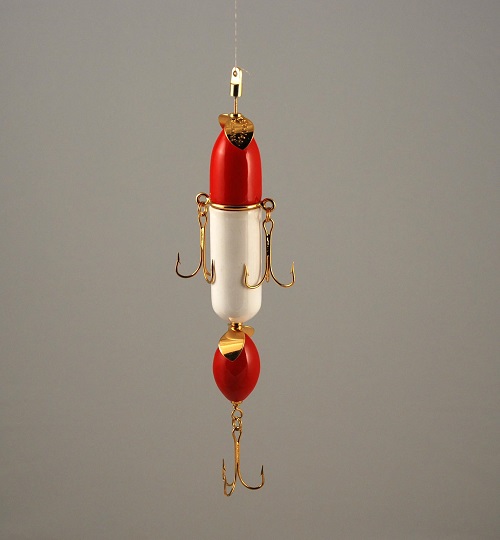
Teuvo has made a copy of another one of Renfors’ products, a large fishing lure.
MORE OF TEUVO’S WORK
As previously mentioned, Teuvo has made some engraved liner lock folding knives. Some engravings are his own and others he has outsourced to Pentti Nieminen. The two liner locks I handled had a pleasant, easy and smooth action.
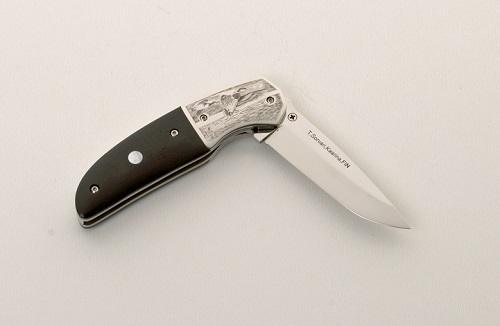
Folding knife in ebony by Teuvo Sorvari, engraving by P. Nieminen.
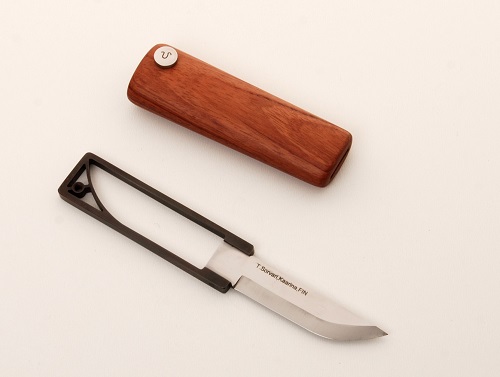
Teuvo’s own design, what you might call a folding puukko. The blade folds into the metal frame and can be inserted inside the wooden handle.
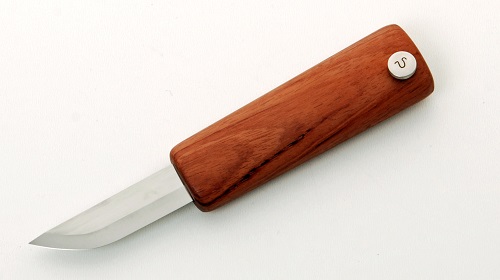
The same knife assembled and ready to use. The screw at the top attaches the handle firmly to the blade.
There are also numerous other models of puukko Teuvo has made. Most of them are his own design, some incorporating aspects from e.g. Tommi and Ilves puukko models and other classic all purpose puukkos. Other items in his repertoire include for example bowie knives, fulltangs, framelock folders, leukus, axes, fishing lures and kuksas (wooden cups).
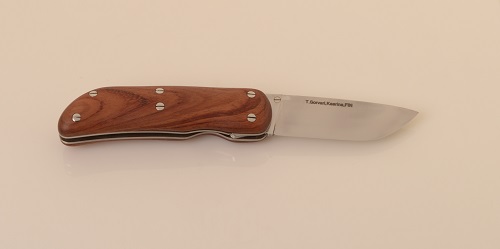
A folding hunting knife.
Below is a selection of some more conventional models of Teuvo’s puukkos.
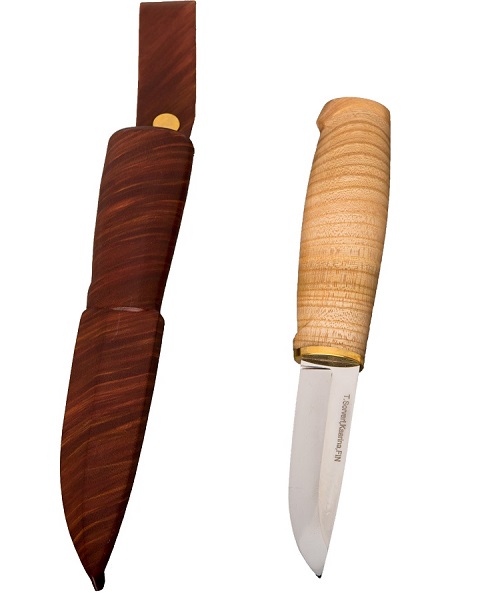
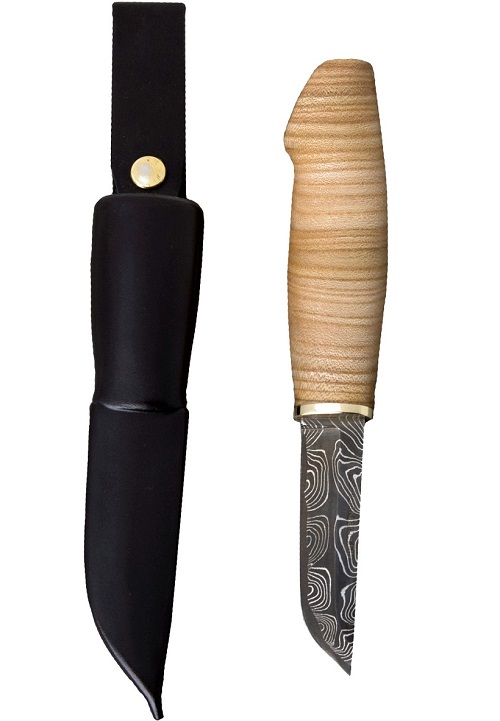
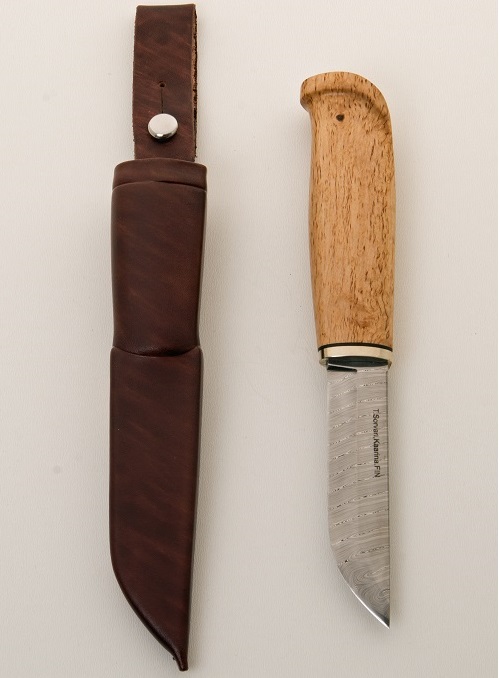
I’ve compiled this article the best I can – if you can provide more information or want to correct something I’ve written on the historical knives, feel free to use the comments section.
All the photos in this story, where not indicated otherwise, are from Teuvo Sorvari.




